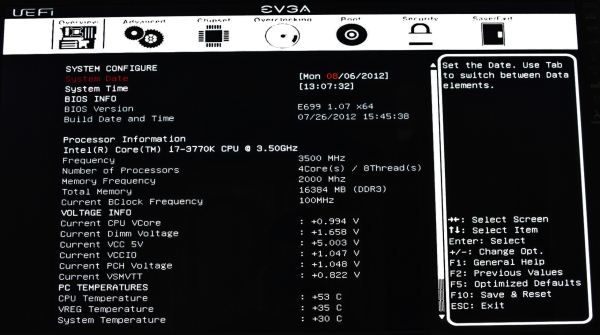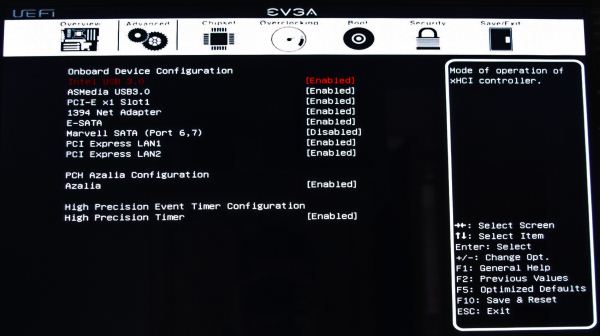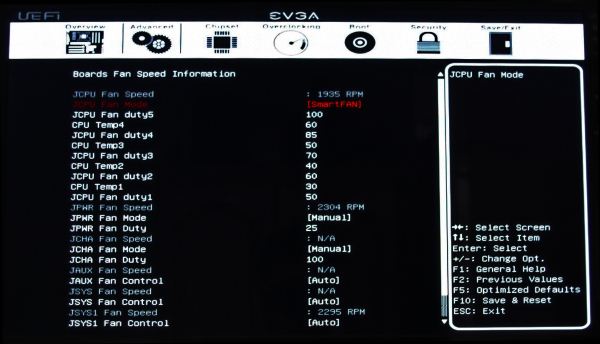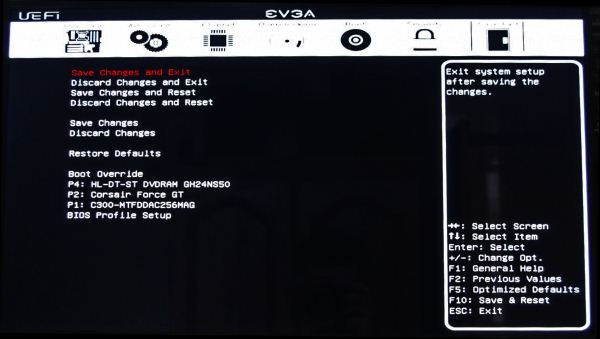Four Multi-GPU Z77 Boards from $280-$350 - PLX PEX 8747 featuring Gigabyte, ASRock, ECS and EVGA
by Ian Cutress on August 22, 2012 9:15 AM ESTEVGA Z77 FTW BIOS
There are a very few companies who have yet to make the switch from a plain interface BIOS to the new wave of graphical interaction. EVGA is in this boat – while their BIOS is technically a UEFI, it still relies on keyboard controls and simple menu selections in order to get the options correct. Any semblance of an easy screen for all the basic information and/or fan controls are out of the window here, users have to explore to find the options they want, alongside a ton of options to which I have no clue what they do.
It should be noted at this juncture that the BIOS for the EVGA Z77 FTW currently follows Intel specifications for CPU Turbo implementation, such that for an i7-3770K we have 39x/39x/38x/37x multipliers for 1/2/3/4 core loading. Some other motherboard manufacturers use what ASUS call ‘MultiCore Enhancement’, which gives 39x/39x/39x/39x multipliers under the respective loading for better performance at the expense of increased heat, temperature, and potential longevity. EVGA will be implementing this feature in a later BIOS, however for our review we were locked into BIOS 1.07, the latest available on the EVGA website at the time of testing.
I would also like to note that the BIOS does not have a print screen function, so I apologize in advance for the potential poor quality of the upcoming BIOS images taken with a cheap $600 DSLR without a tripod.
Our first BIOS screen, while not graphical, contains the wealth of information I would expect from every manufacturer on the market. We have access to the BIOS version and build date, the processor being used as well as speed and cores/threads, memory speeds and amounts, and voltages/temperatures of the important components of the motherboard. Despite not being the most well presented set of information possible, it does satisfy the criteria needed by system builders, integrators and debuggers without needing to open the system and pry the CPU cooler off / install an operating system.
As long as the BIOS is updated from the early betas, we get a system which enables AHCI for the SATA ports by default, which is always beneficial. Unwanted controllers can be disabled through one of the ‘Onboard Devices’ sub-menu under ‘Advanced’. The EVGA Z77 FTW POST time benefits a great deal if the Marvell SATA controllers are unused, dropping from 19.55 seconds to 11.21 seconds when everything is disabled.
Fan controls are found under the ‘Advanced’ menu. We have access through the BIOS to a complex multi-point fan control system (no mention of gradients) that allows users to select a direct correlation between temperatures and fan speeds under the CPU header. Unfortunately this control is not provided through software as well, which is a shame given that these controls outshine some of the ones provided by top-tier manufacturers.
EVGA has a history of overclocking records – not surprising, as they have had on staff over the years some of the world’s most famous extreme overclockers, including Vince ‘Kingpin’ Lucido and Tsemenko ‘TiN’ Ilya. So when it comes to the overclocking section of their top line Z77 motherboard, we might expect some fantastic new features to help.
On the first main screen we get all the important CPU options – CPU multiplier control, LLC (VDroop) control, OCP (Over-Current Protection), Performance Teaks, and important CPU and system voltages. One feature worth explicitly mentioning is the OC Mode option – this is ideal for competitive overclockers, as it automatically disables all non-essential controllers on board to maximize stability. I like this feature.
Memory options are found in the ‘Memory Configuration’ menu, which give access to apply XMP profiles, or manual settings across the ranges. EVGA tell me that they have recently been working hard to ensure that XMP functionality will work across a wide range of kits, however my aggressively timed memory kit (DDR3-2400 9-11-11) that I use for Z77 reviews failed to register, neither would it work with additional VTT voltage. As a result, we had to run the kit at DDR3-2000 9-11-11 for our testing, which is not much of a difference in our testing suite.
C-State options are under the CPU configuration menus, and the BCLK adjustment is performed through its own menu. BCLK adjustment could easily be moved into the main OC menu with the multiplier adjustment, and my attempts at manipulating the BCLK heavily were not that successful – while most motherboards will happily boot with 108 MHz on my i7-3770K, the EVGA board was happy only at 104 MHz. I am unsure as to why this is the case, when I have seen results for the Z77 FTW hitting 108 MHz+.
The EVGA BIOS also comes with Boot Override, allowing for a single-time boot from specified device.





















24 Comments
View All Comments
Namesblank - Tuesday, July 26, 2022 - link
10 years later, people be looking for how to build system with 20+ GPUs lmaomayankleoboy1 - Wednesday, August 22, 2012 - link
Where are the GPGPU benchmarks? AFAIK, those are affected by the PCIE 3.0 bandwidth, as shown in the HD7970 review.Games are more or less happy with a PCIE2.0 x8 .
MrSpadge - Thursday, August 23, 2012 - link
A few GP-GPU apps are affected, most aren't. Even PCIe 3 is slow as hell from the perspective of the GPU, so you try to avoid external communication as much as possible.TimoKyyro - Wednesday, August 29, 2012 - link
I was hoping to see some GPU rendering too. I'm using CUDA on Blender and I really need more GPU power. It would be nice to know if there is a difference between 4x 680 or 2x 690 on different PCIe setups.extide - Wednesday, August 22, 2012 - link
Thanks for providing the diagrams of lane routing. I wish ALL manufacturers would supply a diagram with their boards so you know how to set it up when you are building a system. Sadly, these diagrams are the exception, not the rule. :(processinfo - Wednesday, August 22, 2012 - link
For me only EVGA seems worth consideration (I don’t like a fan on chipset though).I have few requirements that others do not meet.
I want PS/2 keyboard port (don’t care about mouse). I don’t see it as legacy. It is still superior to USB for keyboard. Works on interrupts instead of pulling, allows as many keys pressed without ghosting as you wish (know it probably does not matter in real life but I like that anyway).
Display port output is mandatory for me these days. While it is true that this kind of mobo will run dedicated graphics card (or more than one for that matter) I like to have output here for possibility to use it with CPU graphics if my graphic cards breaks and needs replacement (I had that happen and waited almost two weeks for new one). HDMI is no go because does not support high enough resolution.
Gigabyte is out for me because audio chip. Maybe it is better but it does not do 7.1 and I will lose two channels in my Tiamat 7.1 headset.
rwpritchett - Wednesday, August 22, 2012 - link
You should check out some of the newer USB keyboards. I don't know how they do it, but some of them can now do full NKRO without PS/2. My Nighthawk X9 can do full NKRO over USB.processinfo - Thursday, August 23, 2012 - link
Interesting but this is not possible with standard USB keyboard protocol. If it does that it has to use some tricks and most likely custom keyboard driver.Also I have Thermaltake Meka G1 that I like and I purchased because I got tired replacing membrane keyboards so I rather buy motherboard with PS/2 then new keyboard.
My point is that at this price point and clearly meant for gamers (who else is using more than one graphic card in non-workstation pc) they should think about such details especially when they go overboard with other ports, e.g., who needs all 4 kinds of display output on gaming mobo, or 10 USB ports on back plate alone (if you need plenty you can have them on bracket connected to header).
MacGyverSG1 - Wednesday, August 22, 2012 - link
I loved the review. The G1.Sniper 3 was on my short list for a while. Could get back on, though.I'm waiting for the ASUS Maximus V Extreme to get tested next.
I only need a motherboard to complete my new build. I plan on running this new rig for 6+ years so I want a board that can keep up with the times.
just4U - Thursday, August 23, 2012 - link
I am staying away from the Rampage/Maximus lines from Asus this time out as Gigabyte has pretty much brought better value accross the board on their gamer boards. I don't expect Asus to catch up till the next chipset..